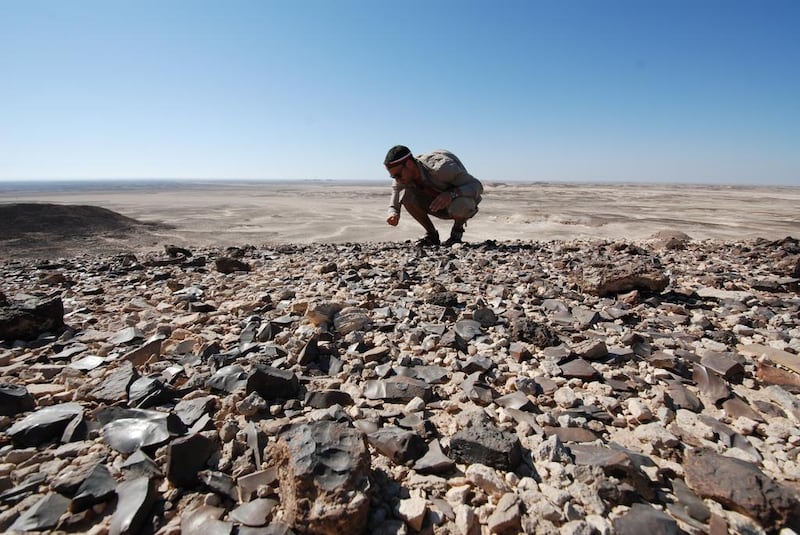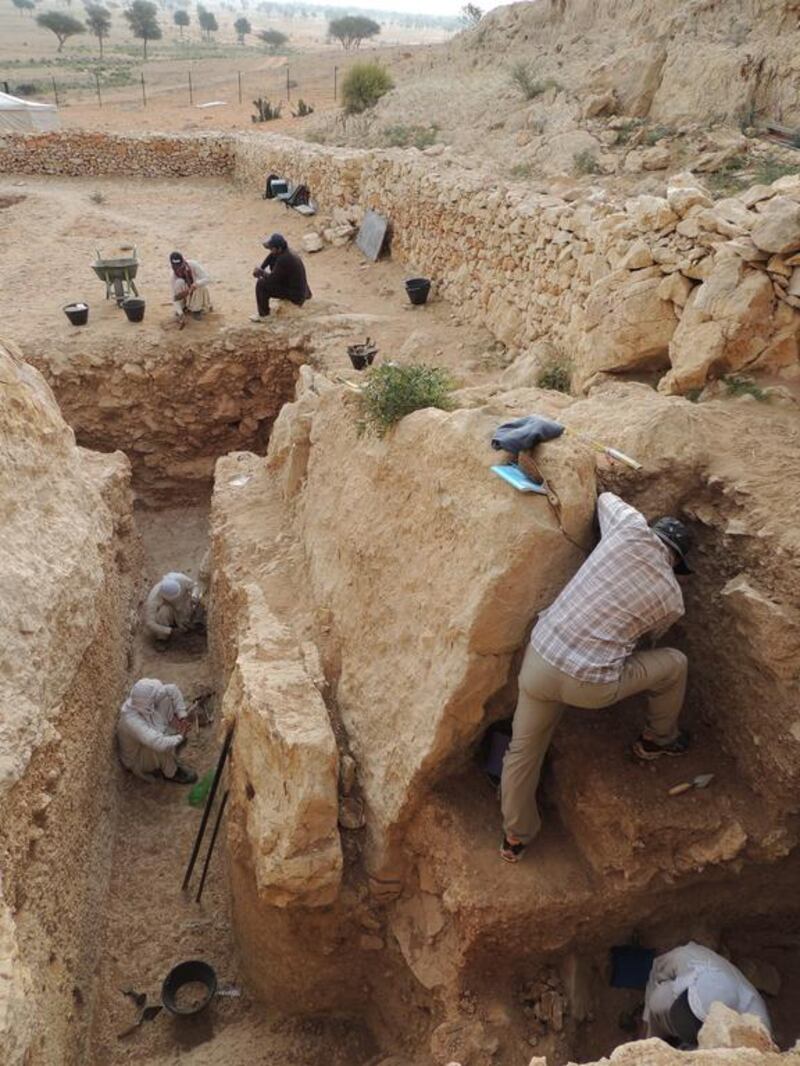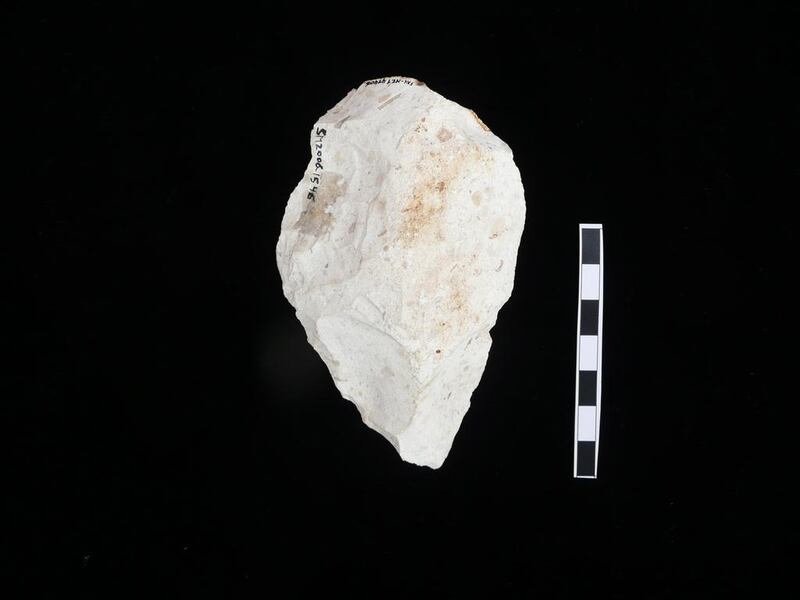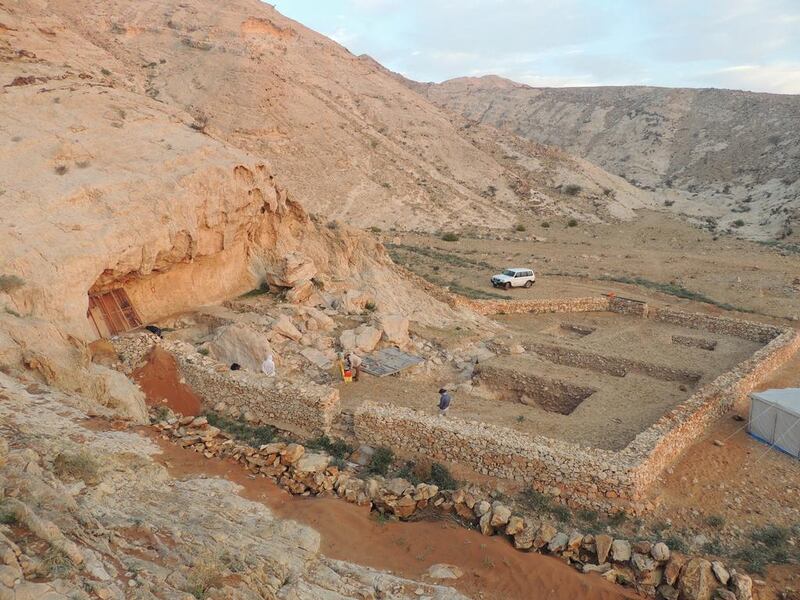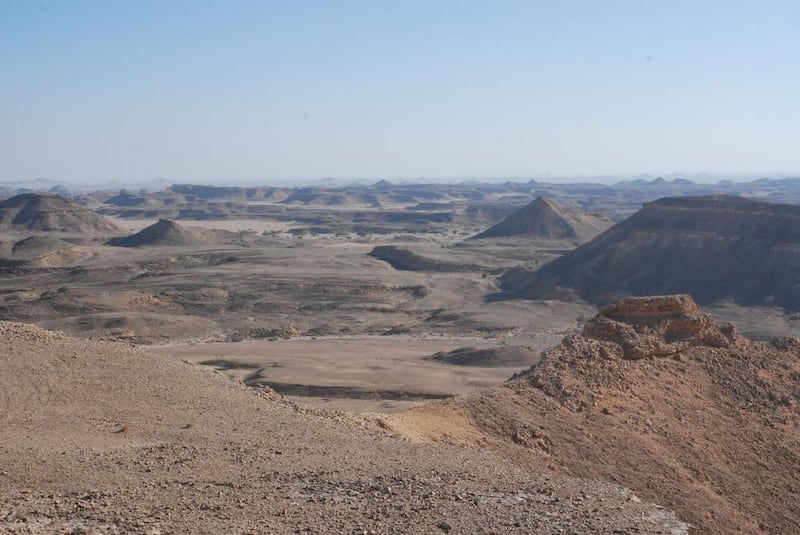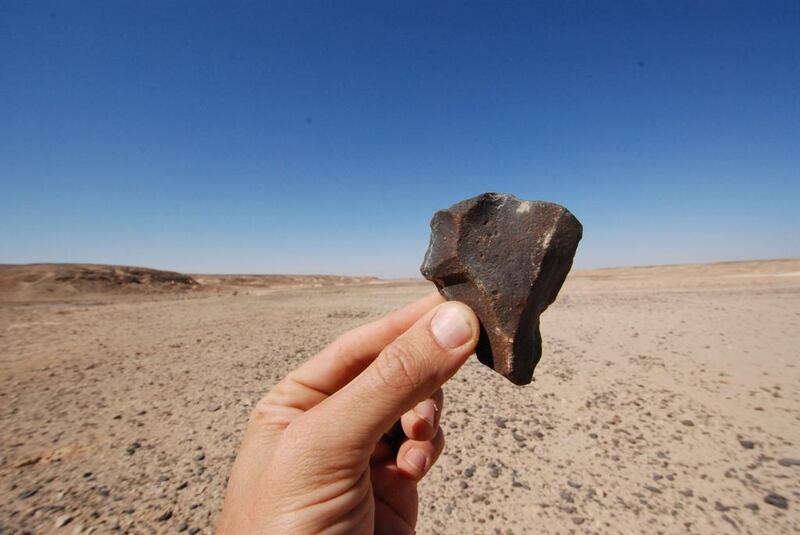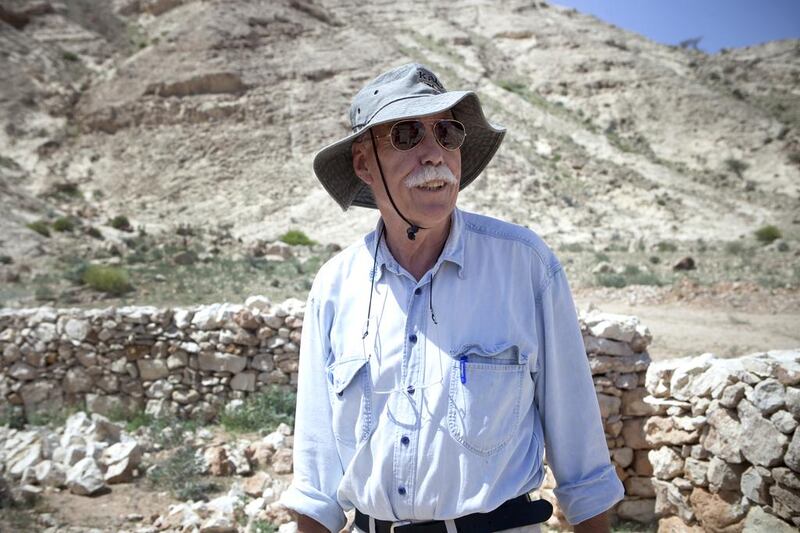In March, archaeologists made a discovery in Sharjah that not only promises to shed new light on the role of Arabia in prehistory but also has the potential to rewrite the history of humankind.
The discovery was a prehistoric tool factory composed of more than a thousand stone fragments including four hand axes, scrapers that would have been used for the cleaning and preparation of animal skins and lithic preforms, rough, incomplete and unused stones still awaiting the final trimming and refinement that would have transformed them into tools.
“They may be 200,000 or even 500,000 years old, we don’t know yet, but they certainly push back the earliest evidence for human occupation in south-east Arabia,” says Knut Bretzke from Eberhard Karls University in Tübingen, Germany, the leader of the team responsible for the find made in Suhailah, north of the oasis town of Dhaid.
Like an increasing number of archaeological finds discovered across Arabia in the last decade, Bretzke’s “lithic assemblage” poses a challenge to the standard ‘out of Africa’ model of early human dispersal that has dominated the scientific consensus since the late 1990s.
“The model usually says that modern humans came out of Africa between 50,000 and 60,000 years ago, but it is important to realise that we now have archaeological evidence to support the theory that there was an earlier expansion of modern humans,” the archaeologist explains.
“And now there is more and more evidence from both genetic studies and from other finds in Arabia and Asia that there might have been multiple expansions earlier than that.”
If Bretzke’s analysis is correct, then the tools not only testify to the human occupation of Arabia at least 75,000 years earlier than was previously accepted, but Suhailah is also one of the most important prehistoric archaeological sites, not just in the UAE but across the whole of the Arabian Peninsula.
“It is undisturbed and we can now collect and study the lithics systematically and that will provide an insight into human occupation during the middle Pleistocene,” the 40-year-old archaeologist explains.
But while Bretzke remains optimistic that field work will enable his team to discover more evidence at Suhailah, he admits that arriving at a more precise date for the assemblage is unlikely.
The finds were discovered at ground level and not as a result of excavation, making dating difficult. “So far it is not possible to provide an absolute date for finds that are discovered on the surface. Of course, the axes have special characteristics that allow me to put them in a time frame between 200,000 and 500,000 years ago, but that is only based on their shape and the technology they employ.”
If dating Suhailah is to remain a matter of interpretation, the archaeologist is more confident about establishing absolute dates for his discoveries at Jebel Faya, another Sharjah site where Bretzke has overseen excavations since 2012.
“We’ve excavated about 150 square metres and we went down, at the deepest point, to about four metres fifty below the surface,” the German says.
“We’ve discovered a sequence of seven layers and we’ve collected samples and submitted them for dating. We’re still waiting for the results, but the point is that we now have a sequence of seven potentially Palaeolithic layers that can be dated and connected to those that have already been excavated with some younger Neolithic and Bronze Age finds on top.”
Bretzke hopes to have dates for these layers by the end of the year thanks to a chronometric dating technique called optically stimulated luminescence (OSL) technology.
Rather than dating the finds themselves, OSL provides a date for the layers of sediment in which they are found by measuring the amount of energy trapped inside grains of sand.
The precise amount of energy provides a date for each layer by determining the last time it was exposed to light.
“The deepest layer should date to about 125,000 years ago, but we still do not know for sure about the uppermost layers. But, given the morphology of the cave and the sedimentation, we believe that they are late Pleistocene, maybe 12,000 or 13,000 years old. We cannot be sure, but the assemblages do not look like they are Neolithic.”
For Bretzke, the importance of these layers comes from their potential to shed light not just on the early occupation of Arabia but how the Peninsula’s settlement was related to changes in climate, the origins and destinations of Jebel Faya’s inhabitants and how long they stayed.
Working with Professor Adrian Parker, a geographer from Oxford Brookes University in England, Bretzke has analysed Jebel Faya’s layers of sediment and the presence of phytoliths, microscopic silica structures that collect in plant tissue and persist in the ground long after a plant’s decay, to establish links between the site’s occupation and changes in the prehistoric climate and vegetation.
“We studied the grain size [of the sediments] and drew some conclusions about how they were deposited because you can distinguish between deposition under wet conditions and dry conditions,” Bretzke explains.
“We also found evidence for palms on the site. Of course, we don’t know whether they were naturally occurring or whether people brought them there, but they must have been somewhere in the vicinity.”
Bretzke and Parker concluded that the layers of archaeology and settlement periods at the site always related to wet periods and that layers without archaeological evidence related to dry periods.
“There is no permanent water source at Jebel Faya so you rely on precipitation and surface water. As soon as it stops raining, you would have to leave,” the archaeologist says.
“The sequence [of finds] also gives us detailed information about the technology that was used. I have assemblages with characteristics that I cannot find anywhere else and each is radically different,” Bretzke explains.
“That suggests there were pulses of settlement rather than continuous occupation but that the incoming populations came from different directions.”
Sitting midway between the Hajar Mountains and the shoreline of the Arabian Gulf, Jebel Faya is a 20-kilometre-long limestone escarpment that runs north-south through central Sharjah.
Part of its attraction to early human populations, Bretzke suggests, is that it sits on an ecotone, a point of transition between habitats where the very different environments of the mountains, the desert and the Dhaid-Madan plain meet.
“It’s a very interesting setting for hunter-gatherers because it provides you with access to three different habitats where you could hunt different species,” the archaeologist explains.
About 125,000 years ago, it is likely that the area around Jebel Faya would have been a savanna-like home to gazelles and dromedaries in desert areas, ibex or wild goats in the nearby mountains and wild asses in the plain.
Before March 2006, however, when the first pieces of a hand axe started to be identified, Jebel Faya was primarily known to research teams as a place relaxation.
“When Hans-Peter Uerpmann discovered the site there was no palaeolithic archaeology on the surface at all, but he was convinced that the situation was so perfect that he had to excavate,” Bretzke says.
“His team used to go to Jebel Faya on their days off and they would sit in the rock shelter there which made a lot of sense because the site is set back and you are protected. Even during strong winds or sandstorms on the plain excavation is always possible.”
Three metres deep and 15 metres wide, the overhanging rock shelter is Jebel Faya’s principal archaeological site, FAY-NE1.
“There may be some places in Yemen where you could find something like this but [at the moment] Jebel Faya is unique in the whole of the Arabian Peninsula,” Bretzke says.
“Usually in Arabia you have the problem that you find things on the surface, or maybe you find just one layer if you dig down, but Faya provides a series of assemblages dating to 125,000 years ago and younger, there are even two layers below 125, so there is this really long sequence that covers the complete late Pleistocene period.”
Hans-Peter Uerpmann started excavations at FAY-NE1 in 2003 and caused a sensation in 2011 when, along with Simon Armitage from Royal Holloway, University of London, he published a paper "The Southern Route 'Out of Africa': Evidence for an Early Expansion of Modern Humans into Arabia" in the journal Science.
Not only did the paper claim that Jebel Faya provided evidence of the arrival of anatomically modern humans in Arabia as early as 125,000 years ago, but it also proposed that they arrived via the Red Sea’s Bab El Mandeb Strait and not via the Nile Valley or the Near East, as had been suggested previously.
“These ‘anatomically modern’ humans – like you and me – had evolved in Africa about 200,000 years ago and subsequently populated the rest of the world,” said Armitage in 2011.
“At Jebel Faya, the ages reveal a fascinating picture in which modern humans migrated out of Africa much earlier than previously thought, helped by global fluctuations in sea-level and climate change in the Arabian Peninsula.”
“Up until now we thought of cultural developments leading to the opportunity of people to move out of Africa,” Uerpmann told journalists at the time of the report.
“Now we see, I think, that it was the environment that was the key.”
While there was widespread agreement about the site’s importance and uniqueness, the claims made by the Jebel Faya team provoked vigorous debate within the academy.
Sir Paul Mellars, professor emeritus of prehistory and human evolution in the department of archaeology at the University of Cambridge, told Science that he believed the team's conclusions were flawed.
“There’s not a scrap of evidence here that these were made by modern humans or that they came from Africa,” Mellars said.
Stony Brook University’s John Shea was also not persuaded about a direct link between Africa and the early toolmakers at Jebel Faya.
"I think the verdict here is ambiguous," the paleoanthropologist told Scientific American's Katherine Harmon.
Shea stated that given all homo sapiens originated in Africa, “it is likely that either [the tools’] makers or their makers’ ancestors came from Africa” — but not necessarily directly.
Shea’s call for caution is echoed by the archaeologist Jeffrey Rose, director of the Dhofar Archaeological Project.
“When Jebel Faya was published there was a bit of a race going on to decide which team would be the first to find the finger print of early humans [in Arabia],” Rose explains.
“But now I think in the race to prove the out of Africa expansion people missed the most important thing about Jebel Faya, which is that it doesn’t really look like anything else. It’s very regionally distinct.”
Rose believes that the primitive techniques displayed in the assemblages at Jebel Faya prove that they are more likely to have been produced by archaic humans who could have entered Arabia as early as 200,000 years ago.
“I think it’s a much older group that’s still living there because it’s a very crude way of making tools,” Rose explains. “From my perspective what this says is that there is an separate population holed up here that is unrelated to anybody else and to me that’s the most fascinating part about Jebel Faya.”
Rose has been working in Southern Oman and Yemen for more than a decade, searching for archaeological evidence that might shed light on the area’s role as a possible route out of Africa.
“There was a theory at the time that humans had moved along the coast, had developed fishing technology and this new ecosystem enabled them to get from East Africa to Australia in a relatively small amount of evolutionary time,” the archaeologist explains.
In 2010, after six years’ searching without any results, Rose and his team began to discover lithic assemblages during their final season in the field that displayed a very specific type of stone tool technology used by the “Nubian Complex,” nomadic hunters from Africa’s Nile Valley.
“This way of making stone tools had only been found in Africa along the Nile Valley up until that point,” Rose says. “We dated the finds to about 106,000 years ago and they pretty well matched the ones from the Nile Valley and once we found one site and started looking for them we found about 200 more all down in southern Oman.
"We'd hit the jackpot," Rose told National Geographic. "It was scientific euphoria. We had never considered the link to Africa would come from the Nile Valley, and that their route would be through the middle of the Arabian Peninsula rather than along the coast.
“Geneticists have shown that the modern human family tree began to branch out 60,000 years ago. I’m not questioning when it happened, but where. I suggest the great modern human expansion to the rest of the world was launched from Arabia rather than Africa.”
Despite the controversy surrounding Jebel Faya the site’s publication was one of three events that, according to the University of Oxford’s Michael Petraglia, made 2011 an annus mirabilis for prehistoric archaeology in Arabia.
“There were three independent publications in 2011, the one about Jebel Faya, one written by Jeff Rose about Oman and the one by us in Saudi Arabia that identified the first dated and stratified sites in the whole of Arabia which completely changed everything we know about the chronology of occupation in the Arabian Peninsula.”
As well as being professor of human evolution and prehistory at the University of Oxford’s department of archaeology, Petraglia is also the principle investigator for the Palaeodeserts Project, a five-year collaboration between the Saudi Commission for Tourism and Antiquities and University of Oxford which has involved more than 30 scholars from a dozen institutions and seven countries.
One of the project’s major achievements is to have used satellite technology to map the presence of almost ten thousand prehistoric rivers and lakes, many of which are likely to contain unidentified archaeological sites.
Petraglia sums up the magnitude of this discovery in a single phrase, “Green Arabia”.
“Traditionally, there was an assumption that Arabia was marginal to out of Africa dispersals, that deserts were always avoided and that if there was any archaeology it would not be very well preserved, but that was because people really didn’t realise the wealth of the region’s archaeological record.”
“The predominant model in academia has been that, as humans moved out of Africa repeatedly through time over a couple of million years they used the margins of Arabia and avoided the interior,” Petraglia explains. “But we are demonstrating very, very clearly now that is not the case. The bigger picture is that Arabia is now central to our understanding of humanity’s past. It’s not a side story, it’s the central story.”
For Rose, the concept of “Green Arabia” and the picture it paints of climate-dictated dispersals in which hunter-gatherer groups follow game and water courses not only matches the archaeology, it also makes sense.
“People weren’t entering Arabia along its coastline, they were moving into the interior during green periods. They were being opportunistic and taking advantage of an Arabian Peninsula that was covered in grassland, rivers and lakes and the same plants and animals that they were already adapted to in north-east Africa.”
Rose now believes that the story of Arabia’s role in prehistory is now reaching a phase where the archaeological evidence and the models provided by genetic analysis are finally starting to coalesce.
“For a long time it was as if there were two different languages being spoken,” the archaeologist explains.
“Geneticists would go to conferences and they would present this very cut-and-dry story of a human expansion that started 50,000 to 60,000 years ago, but the Arabian archaeologists would be tearing their hair out saying, ‘There is nobody coming to Arabia 50 or 60,000 years ago from Africa. There’s no evidence for that’.”
For Rose this coalescence isn’t just the result of discoveries such as his own or the Palaeodeserts Project, but also stem from a more fundamental shift in perspective.
“All this time we have been looking for an out of Africa but what we should have been thinking about is out of Arabia.”
Nick Leech is a features writer at The National.
